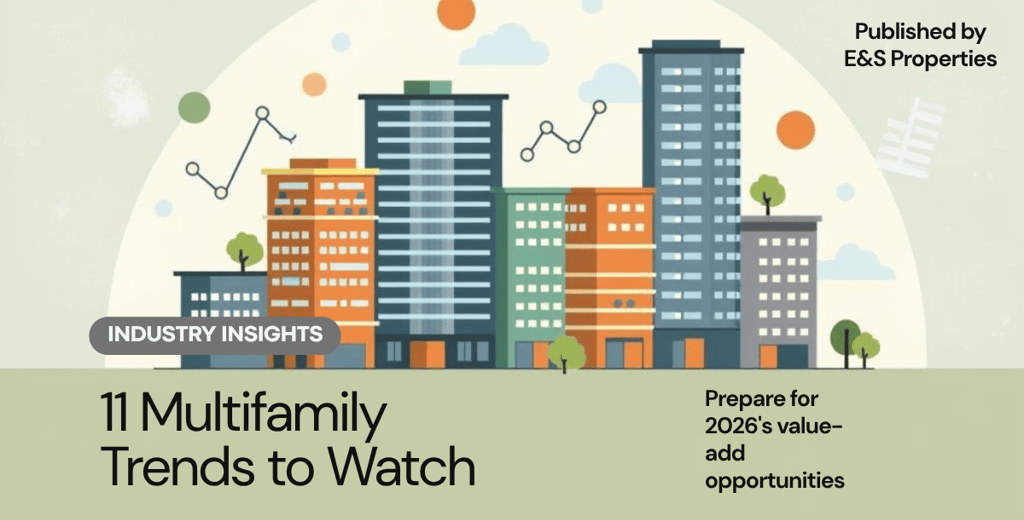11 Multifamily Trends to Watch in 2026 — and What They Mean for Value-Add Investors
From declining construction starts to the rise of AI-powered leasing, the multifamily market is shifting toward operational efficiency and selective growth. This 2026 outlook breaks down key national trends and offers actionable strategies for investors focused on NOI expansion, rent optimization, and long-term portfolio value.
Published by E&S Properties
10/22/20256 min read


Multifamily in 2026: 11 Trends Every Value-Add Investor Should Watch
As we move into 2026, the U.S. multifamily market is entering a new phase—one defined not by runaway growth or panic, but by recalibration. After several years of record construction, rent stagnation, and shifting renter behavior, the next 12 months will test the strategies and patience of apartment investors nationwide.
For value-add investors, that means opportunity. When volatility and supply imbalance drive uncertainty, disciplined operators can find strong entries, reposition underperforming assets, and ride the next wave of stability.
This article breaks down 11 key trends shaping multifamily in 2026, with an eye toward how each creates potential for value-add execution, operational upside, and smarter acquisition strategies.
1. Construction Pipeline Slows — Supply Pressure Eases
After hitting a 40-year record with more than 700,000 new units delivered in 2024, the multifamily construction pipeline is finally cooling off. By the end of 2025, supply additions are projected to fall roughly 30%, and new construction starts have plunged over 70% from their pandemic-era peak.
For investors, this is welcome news. The flood of new deliveries that has weighed on absorption and pushed up vacancy—particularly in the Sun Belt—will begin to taper. In 2026, markets that were oversupplied for the past two years should start to stabilize, creating the perfect conditions for acquiring assets below replacement cost and repositioning them for the next demand cycle.
Markets like Orlando, Austin, and Nashville, where new deliveries are falling fastest, may offer some of the most compelling buy-renovate-refinance opportunities.
2. Rent Growth Returns—Slowly, But Steadily
National rent growth spent much of 2025 hovering near zero, as new supply outpaced absorption. That plateau is about to end. CoStar projects rents will rise by roughly 1.9% in 2026, signaling the start of a gradual recovery.
This will not be a return to the 9% annual rent spikes of 2022—but it doesn’t need to be. For value-add operators, modest rent growth is a signal of stability and predictability, both of which support underwriting and post-renovation premium capture.
Properties purchased today can be renovated and re-leased into a healthier rent environment by late 2026 or early 2027, aligning perfectly with a typical 12–18 month repositioning timeline.
3. Regional Rebalancing: Midwest and Northeast Take the Lead
While the Sun Belt dominated multifamily headlines for the past decade, 2026 will see a geographic rebalancing.
Markets such as San Jose, San Francisco, Chicago, Indianapolis, and Philadelphia are projected to outperform in rent growth, driven by job rebounds, constrained new supply, and renewed urban demand. Meanwhile, high-supply Sun Belt metros like Austin, Phoenix, and Charlotte will need more time to absorb inventory.
For investors, this shift underscores the value of market diversification. Value-add opportunities in secondary Midwest markets—where construction costs are lower and cap rates remain attractive—may outperform trophy Sun Belt deals that still face heavy competition and pricing pressure.
4. Automation Becomes an Operational Advantage
Automation has quietly transformed property management over the past two years, and 2026 will see full-scale adoption. Self-guided tours, AI chatbots, rent payment portals, digital maintenance workflows, and smart-tech leak detection are no longer optional—they’re operational essentials.
For value-add owners, automation is a lever to improve efficiency and reduce operating expenses. Integrating these tools during repositioning can lift net operating income (NOI) by cutting administrative labor and energy waste while improving resident satisfaction.
Think of automation not as a tech trend, but as a renovation phase in itself—a digital upgrade that delivers immediate ROI.
5. AI-Driven Leasing and Marketing Go Mainstream
Artificial intelligence is no longer an experiment in the multifamily space—it’s a line-item strategy.
AI-powered leasing assistants now handle lead nurturing, fraud detection, virtual tours, and even sentiment tracking from online reviews. Between 2024 and 2025, use of AI-generated marketing content jumped 26%, and 2026 will see even faster growth.
For operators, this means two things:
Efficiency — fewer human bottlenecks in lead follow-up and screening.
Insight — data-driven understanding of what drives conversions and renewals.
A value-add investor adopting AI-enabled leasing tools can often compress lease-up periods and reduce vacancy drag, creating a measurable lift in stabilized returns.
6. Centralized Leasing Reshapes Property Management
Leasing centralization—the practice of managing multiple properties from a single hub—has rapidly evolved from a big-operator experiment into an industry standard.
In 2025, MAA’s pilot program saved over 30,000 labor hours annually by consolidating lease administration. Expect smaller and mid-sized property management firms to follow suit in 2026.
For value-add buyers, this trend reinforces the case for portfolio aggregation. Owning multiple assets within a 5–10 mile radius can now yield outsized operational efficiencies through centralized leasing, maintenance routing, and marketing.
7. Transparent Pricing Becomes the Law (Literally)
By 2026, five states—Colorado, Connecticut, Massachusetts, Minnesota, and Nevada—will legally require landlords to display total rent pricing, including mandatory fees.
Nationwide, this move toward transparency aligns with consumer preference: 83% of renters say they want the total price upfront.
For investors, transparent pricing represents both a compliance requirement and a competitive opportunity. Properties that embrace honest, all-in pricing earlier will appear more trustworthy to renters and can differentiate themselves in saturated Class A markets where opacity has been the norm.
8. Concessions Stay Elevated, Creating Entry Opportunities
Concessions have become standard across U.S. multifamily—used by more than 30% of properties nationwide. That trend isn’t going away in 2026.
However, elevated concessions can signal softness ripe for value-add acquisition. When Class A owners offer two months free rent just to fill units, it’s often a sign of over-leveraged pro formas or misaligned pricing.
A well-capitalized buyer can step in, acquire below market value, stabilize rents through renovation and marketing repositioning, and ride the next rent recovery cycle.
Also worth noting: discounted rents over time (vs. one month free) remain the most effective incentive for renters—knowledge that can guide post-renovation lease structuring.
9. Retention Becomes the New Growth Strategy
In high-end properties where vacancy remains above 10%, the emphasis is shifting from attracting new tenants to keeping the ones you already have.
Renewal rent growth now often exceeds that of new leases, and top-tier properties are investing in proactive retention tactics—early outreach, customized renewal offers, and faster maintenance response times.
For value-add investors, this trend highlights a simple truth: resident experience is ROI. When repositioning an asset, improvements that reduce turnover—like better lighting, noise insulation, or amenity activation—often yield stronger long-term cash flow than chasing top-of-market rents.
10. Amenities Evolve to Meet Gen Z Expectations
New construction properties will continue to battle elevated vacancies, especially in the luxury segment. To compete, developers are adding more experiential and lifestyle-oriented amenities—onsite cafés, rooftop gardens, saunas, meditation pods, VR rooms, and even recording studios.
While this level of amenity build-out isn’t feasible for most value-add investors, the takeaway is strategic: today’s renter values experience over extravagance.
A Class B or C property can capture similar appeal through micro-amenity enhancements—think upgraded community Wi-Fi, modern laundry lounges, coworking nooks, or outdoor seating upgrades. These small-scale improvements create differentiation without the capital intensity of full luxury development.
11. Unit-Specific Media Becomes a Leasing Requirement
The modern renter expects transparency—and visuals drive trust. Nearly 80% of renters now want photos or videos of the exact unit they’re considering, and more than half will skip listings that don’t include them.
For Gen Z renters (now the largest share of new leases), that expectation is even higher. They’re 5–9 percentage points more likely than older renters to demand unit-specific visuals or 3D tours.
For owners, this shift has direct operational implications:
Capture unit-level media immediately after renovation.
Integrate 3D tours and labeled photos into listing templates.
Use AI tools to generate automated captions, branding overlays, and syndication to multiple platforms.
It’s no longer just about showing a floor plan—it’s about showing authenticity, and for value-add investors, that authenticity converts into higher lease-up velocity and better rent premiums.
Key Takeaways for Value-Add Investors
The multifamily landscape of 2026 may look calmer on the surface, but beneath that calm is a wave of structural change—operational, technological, and behavioral. Here’s what it means in practice:
Timing favors buyers. With new supply slowing and rents beginning to rebound, 2026 offers a window to buy below replacement cost and stabilize into a healthier market.
Efficiency is the new amenity. Automation, AI, and centralized management aren’t fads—they’re permanent enhancements to NOI margins.
Retention drives returns. Turnover costs erode value faster than inflation. Properties that cultivate loyalty outperform during soft markets.
Transparency wins. Whether it’s pricing or media, properties that communicate clearly attract trust—and trust leases units.
Small upgrades yield big results. Amenity innovation doesn’t have to mean rooftop gardens. The right small-scale enhancements can transform perception and boost rents.
As supply normalizes and interest rates (eventually) ease, the next 12–24 months will reward investors who act decisively but operate efficiently. The key is to approach 2026 not as a year of recovery—but as a year of repositioning.
🔎 Ready to take the next step?
📩 Sign up for our newsletter to get weekly insights on current trends.
📝 Interested in investing? Complete our investor questionnaire and we’ll be in touch with opportunities that match your goals.
